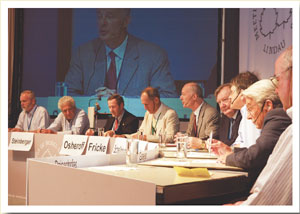The 2008 meeting of Nobel laureates had more than a touch of CERN.
Every summer since 1951 a large number of Nobel laureates gather in Lindau, Germany, at Lake Constance (the Bodensee) and meet with talented young scientists from around the world. These annual meetings, today a permanent institution supported by a foundation, were initiated by the late Count Lennart Bernadotte, a member of the Swedish royal family who had settled on the nearby Island of Mainau in Lake Constance. Count Bernadotte, an outstanding personality with philanthropic, ecological, cultural and scientific interests, established these meetings of Nobel laureates with young scientists with the intention of fostering scientific excellence as well as international cooperation in the spirit of pacifism. Today the foundation is headed by Countess Sonja Bernadotte, assisted by Wolfgang Schürer, visiting professor for public affairs at St Gallen University.
Initially only young scientists from Germany were invited, but over the years the meetings were expanded to participants from Europe and then the world. Some 550 students, postgraduates and fellows currently take part each year, selected by the scientific board of the Foundation Lindau Nobel Prizewinners Meetings. The delegates come from more than 60 countries, of which about 40% are from outside Europe. The proportion of young female scientists has been constantly increasing, reaching 50% last year.
The Lindau meetings usually focus on one of the Nobel prize fields in the natural sciences – physics, chemistry, and physiology or medicine – and rotates between them; a separate meeting on economic sciences with winners of the Bank of Sweden Prize in Economic Sciences in Memory of Alfred Nobel is held every two years. The one-week programme of the meeting of Nobel laureates consists of lectures by the laureates, scientific discussions between them and the young scientists, a round table and social events. The informal contacts are of course a crucial element.

Image credit: Lindau Nobel Laureate Meetings/C Flemming.
This year the Meeting of Nobel Laureates – the 58th in the series – was on physics, with 24 participating laureates, including several particle physicists with close links to CERN, namely David Gross, Gerardus ’t Hooft, Carlo Rubbia, Jack Steinberger, and Martinus Veltman. The lectures included talks by Veltman on “The development of particle physics”, Gross on “The Large Hadron Collider and the Super World”, Steinberger on “What future for energy and climate?” and ’t Hooft on “Humanity in the cosmos”. Also from the field of particle physics, Donald Glaser, who received the Nobel prize for the invention of the bubble chamber, talked about the role of cortical noise in vision, and cosmologist George Smoot described the beginning and development of the universe. The round table centred on energy and climate, following on from talks by three chemistry laureates, and featured contributions from both Rubbia and Steinberger.
Beyond these eminent names, CERN participated this year with a highly visible press event in which Jos Engelen and Lyn Evans talked about the LHC start up and where several laureates discussed questions on the expected results of the LHC. During the event a video link was established to the CERN control centre so that the audience could observe the ramp up of sector 7/8 of the LHC to 8500 A (5 TeV) as it happened.
CERN was also represented among the young scientists attending the meeting. In 2007, I had established contacts with the Lindau Foundation, and as a result, CERN was invited to nominate a candidate with a link to medicine, the field of last year’s meeting. Benjamin Frisch, a student on the Austrian doctoral student programme, working at CERN on the medical applications of microelectronics, was selected. This year CERN was again invited to nominate young scientists. The four candidates selected were a good representation of the range of science and technology at CERN, as well as the laboratory’s international nature.
The annual Nobel meeting in Lindau was once again an outstanding event, full of enthusiasm and brilliant ideas. For the young scientists it was a unique opportunity to exchange ideas and network beyond and outside their scientific subject, making it a veritable feast of science. The international context and the commitment to scientific excellence are basic elements that are common to both the Nobel foundation and to CERN – a good reason to maintain and intensify the links between both organizations.








